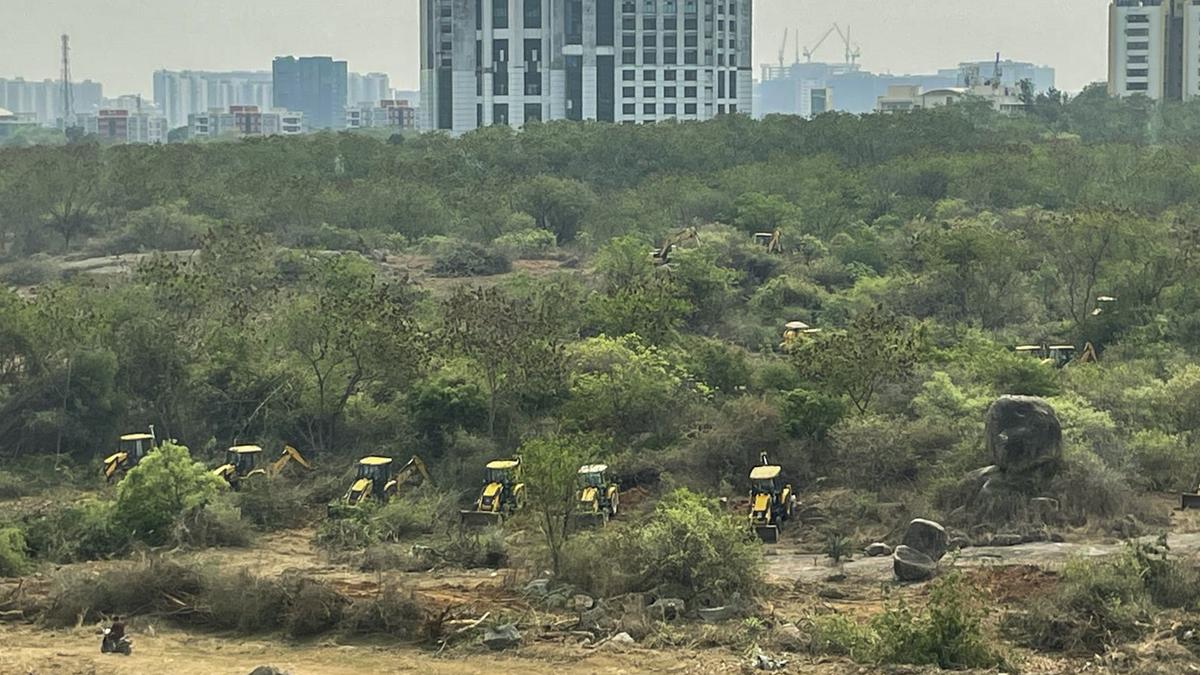At the centre of the controversy over 400 acres of land in Kancha Gachibowli are multiple stakeholders: the Telangana government, University of Hyderabad, students, environmental activists, and political parties. Each views the land differently — as resource, sanctuary, asset, or symbol. File
| Photo Credit: PTI
A blind spot is a gap in our field of vision — a space we cannot see. Yet, we rarely notice it. The brain instinctively fills in the blank using cues from the other eye and surrounding context. One eye compensates for the other. But when it comes to how we manage urban land and design our cities, no such compensation exists. Sustainability is our collective blind spot — always present, rarely acknowledged, and patched over with short-term fixes.
The controversy over 400 acres of land in Kancha Gachibowli, Hyderabad, brings this blind spot into sharp relief. At the centre of the dispute are multiple stakeholders: the Telangana government, University of Hyderabad, students, environmental activists, and political parties. Each views the land differently — as resource, sanctuary, asset, or symbol.
That legal title rests with the state is undisputed. What is in dispute is everything else: what the land represents, who it serves, and what its future should be. For the State, auctioning the land is a pragmatic move to generate revenue, employment, and support Hyderabad’s growth. Those opposing the auction see it is an act of ecological erasure, a severing of community bonds, and a reflection of how development is pursued without a sustainable vision.
The land in question is not barren; it is ecologically rich. Over time, it has become a biodiversity hotspot, a carbon sink, and acquired hydrological significance. It shelters ancient rock formations, seasonal water bodies, and a range of vulnerable flora and fauna. In a city where rising temperatures are a lived reality, the cooling function of such spaces is not just ecological — it is essential to urban habitability.
Despite decades of rhetoric around ‘sustainable development,’ urban land management continues to operate on a short-term horizon. Environmental assessments are cursory, if conducted at all. Communities are often sidelined in the decision-making process. And the idea that some spaces hold value precisely because they are left untouched — that preservation is a form of progress — remains alien to existing urban planning frameworks.
Legally, the government stands on firm ground: the land belongs to the State, affirmed by revenue records and judicial pronouncement. But law’s clarity on ownership does not equate to legitimacy in how that ownership is exercised. Applicable legal frameworks offer no substantive guardrails for ecologically responsible land use by the government. The result is a legal vacuum where decisions that shape our cities are made with little accountability to sustainability.
This vacuum reflects a deeper inconsistency in urban policy. On paper, both the National Urban Policy Framework and State-level master plans invoke sustainability, environmental stewardship, and inclusive growth. In practice, these principles rarely survive the test of commercial opportunity. The proposed auction of Kancha Gachibowli is a textbook example.
What makes this moment even more jarring is the response to those protesting it. That students are being silenced, even met with force, is painful. This is a community driven not by gain, but by a shared sense of ecological responsibility. Yet their dissent is trampled by the very institutions meant to protect them. That excavators entered despite protests and continue to clear swathes of greenery is a brutal reminder of how brittle our developmental imagination has become.
In a city saturated with underutilised commercial real estate, this move is not just short-sighted; it is thoughtless. It reflects a mindset that still treats land as commodity, not commons, and ignores the planetary crisis unfolding around us. What Kancha Gachibowli lays bare is not a lapse in legal authority, but a deeper lapse in vision — a kind of Great Derangement that refuses to acknowledge what lies in plain sight. This blind spot is no longer passive; it has become institutionalised. The State, armed with title and administrative machinery, is approaching the land with a transactional mindset rather than one rooted in long-term stewardship. What is needed is not just legality, but leadership shaped by ecological foresight and a commitment to an inclusive, sustainable future for Hyderabad. Land is the optic nerve of our cities — and the 400 acres at Kancha Gachibowli show just how deep our blind spot runs. The question now is whether we have the will — and civic imagination — to see beyond it.
Navya Jannu is an advocate practising at the Supreme Court of India
Published – April 15, 2025 01:18 am IST
